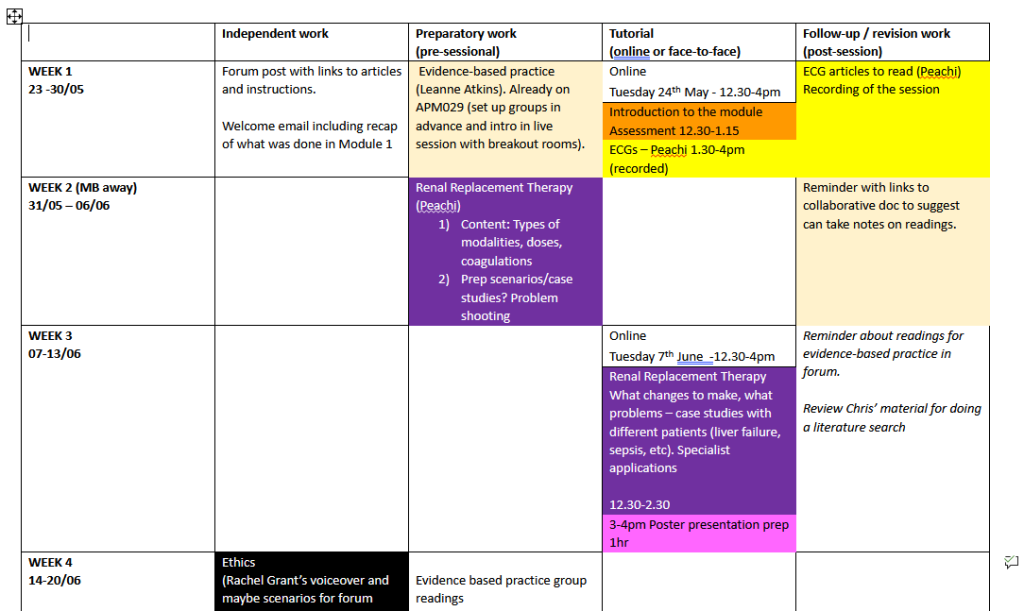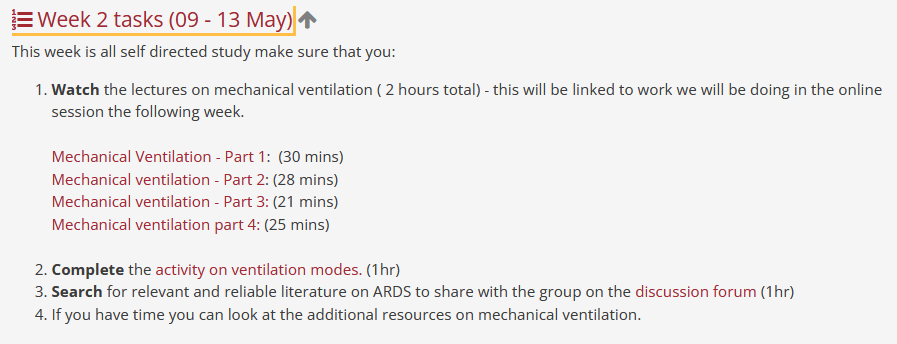For the last two years I have been fortunate to work with Nursing lecturers Maria Bliss, Julie Robinson, Peachiammal Subramanian and various other City colleagues to collaboratively design and deliver a new Post Graduate Course in Critical Care. This post is a personal reflection on the lessons learnt from being involved in the learning design process.

Background and overview
The course was funded by Health Education England (HEE) who wanted to ensure accessible, equitable and standardised critical care training with a more blended learning approach. The original bid timeline was for all programme development work to take place by November 2021, but delays from HEE left the course lecturers with just three months for course design and creation before teaching started.
The PG Cert is composed of two 30 credit modules and a foundation module and is designed for adult nurses as part of their required training while working full time. Modules consist of guided independent learning and taught sessions (online or hybrid on campus) every other week for ten weeks.
The programme incorporated the National Competency Framework for Registered Nurses in Adult Critical Care (CC3N Steps 2 & 3) and course assessment included completion of these work based competencies.
Learning design
LEaD got involved in the project when the modules were going through final amendments in Programme Approval and Review Committee (PARC). The course lecturers are part-time and were already teaching on existing modules so were very time limited. We started with an initial 90-minute online learning design workshop based on the UCL ABC learning design approach which uses a storyboard to map out student activities week by week. This was done originally done online using PowerPoint but in the second iteration we held a face-to-face course design session as it was easier to view the module all at once on paper and move Post-it notes around.

We adapted the workshop and storyboard to include the blend between online and live teaching activities each week.

Activities and content were then detailed in a table in Word and broken down according to when students were required to complete activities and resources (independently, in preparation for the synchronous teaching session, during the synchronous teaching session or after the synchronous teaching session).
After the first planning session we continued with weekly catch ups. In addition to course design, LEaD worked with the lecturers to support them to learn new technologies and with hybrid delivery.
Course design
Online or blended learning requires much more up-front preparation. Resources that had been carried out in class required much more explanation and feedback when they were adapted to independent learning activities. Because of lack of time, we encouraged academics to have a plan b and c when it came to creating course content. For example, the initial plan featured numerous narrated PowerPoints, but they are very time intensive to create and student feedback indicated that they found standalone PowerPoints just as useful especially if accompanied with supporting resources and activities such as quizzes or H5P activities.
We encouraged the use of pre-existing University systems to build in accessibility and evaluation from the start. The course was included in a pilot to test out Anthology Ally in Moodle to try and ensure that all content was accessible and available in alternative formats for students.
Moodle
The majority of learning took place online and had to fit in with varied shift patterns, so the structure of the course had to be easy to follow with tasks as clear as possible. Regular communication was built into the design to prompt and remind students of the tasks and encourage engagement reinforcing the links to the work-based competencies. Weekly course announcements were sent using the Moodle forum and an informal video message from lecturers on each independent study week.

Activity completion was used for any tasks that were required each week along with a weekly task list with timings for each activity so students could plan their week. This also allowed academics to view student engagement at a glance and flag up any students that may be struggling as soon as possible.

Reading lists online were used to indicate required and additional readings with extra detail added to give context. MediaSpace was used with playlists and channels and all recordings were caption corrected using the caption correction service.
Activity restrictions were used to reveal content to students at the same time each week and content was made available two weeks in advance of teaching and after student feedback. This was increased to three weeks to allow for students to plan and structure their learning around annual leave, work and caring responsibilities.
Groups and groupings were used to restrict access to resources for group work and to divide Level 6 and Level 7 assessments.
Taught sessions
Each module had three online sessions and two full days on campus hybrid sessions. Guest lecturers from the sector were able to join either online or in-person. The taught sessions were focused on feedback and discussion. Students were regularly asked to work on case studies in groups. The first cohort used Teams for online teaching as this was the platform that the teaching staff were comfortable with but as student numbers increased and hybrid teaching was brought in the course moved to using Zoom.
Active learning was encouraged using collaborative documents and as numbers increased PollEverywhere was introduced to provide opportunities for staff to test understanding and give formative feedback to students.
Student feedback and revisions
The modules ran three times a year and each intake had an increase in student numbers with the introduction of students from Bristol and hybrid teaching in the second iteration. Student feedback was positive and combined with good attendance at teaching sessions and engagement with activities on Moodle.
Students reported that they valued the taught sessions as they appreciated getting the opportunity to hear from the expert lecturers and ask questions. They found the quizzes and scenarios extremely useful and are more likely to review slides than watch the narrated lectures but do appreciate the option of going over something more in depth. They struggle to keep up with the independent study and would appreciate more feedback and opportunities to test their understanding.
Several changes were made with each iteration of the course including introducing bookable online office hours using Moodle scheduler and introducing a video from the support librarian and academic skills resources.
Lessons learnt
- Time is limited for staff and students so keep it simple and make it easy for them. Moodle should be as clear and user-friendly as possible with a consistent approach each week and across modules on a course.
- Be flexible with the approach you take and the resources and activities you aim for (have a plan b & c).
- Students are strategic learners and we found more engagement with asynchronous activities which had instant feedback such as quizzes than with asynchronous resources such as narrated PowerPoints, although many students reported that they did find the PowerPoints useful.
- The most important requirement to create a successful online course is academics’ time.
- Blended learning works best if academics make regular connections between the online and in- person content and resources and activities. Regular communication can help to establish a teacher presence and can be done in various formats including short videos, group forum posts and individual feedback.
- Make it sustainable, build in automation, scalability, accessibility, evaluation and reporting.
- Always try and future-proof when creating asynchronous resources and activities don’t include dates so they can be reused each year.
- Be realistic: what are students being required to do each week is it feasible? Does it link together and will the online activities be referred to in taught sessions?
- Build in checks to easily keep track if students are engaging and how they are doing.
Reflection
Working closely with the academics has been an insight into the realities of the workload pressures that many City teaching staff are under. The course has now been running for three cohorts and the main challenge has been lack of time for academics to reflect, evaluate and make revisions. As the cohort has scaled up to over 100 students per module it has been harder to manage hybrid teaching and next year will see two in-person sessions running simultaneously in London and Bristol.
I am in awe of the work and time that Maria, Julie and Peachi have put into making this programme a success and it has made me reflect on the realities of running a course. As a sector we need to develop workload models that include time for professional development, course design and preparation for teaching.
If you are interested in getting support with programme or course design LEaD will be launching a new digital learning design service. You can hear more about it at the LEaD light lunch Thursday 1st June (12.30pm) on Teams.
